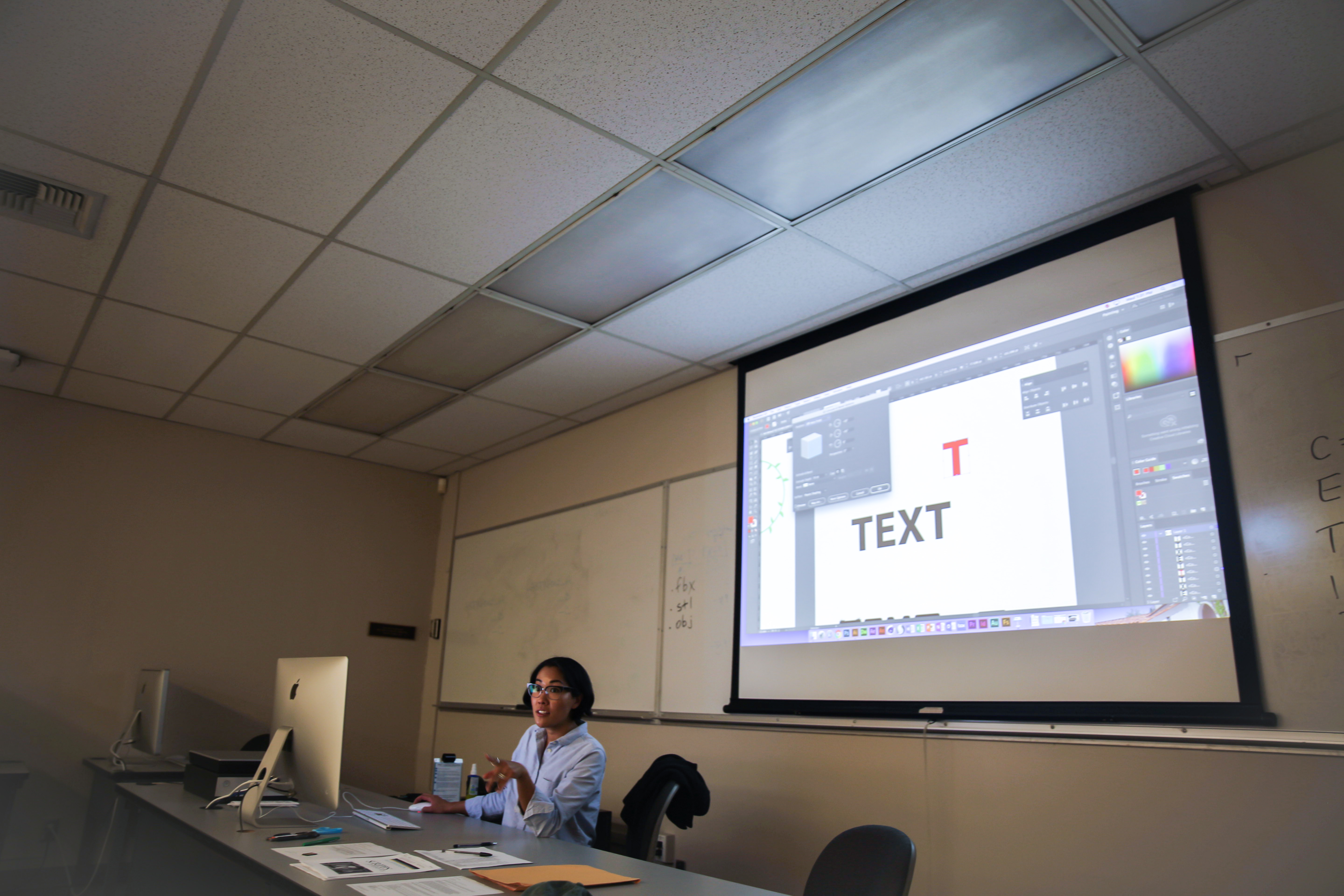By Ella Murdock Gardner ’22

“It’s a great day to create!” exclaims Visiting Assistant Professor of Art Melanie Nakaue ’01 as her intermediate digital art class files into the studio. Once everyone sits at their computers, she launches into her typography demo, projecting onto a screen at the front of the room so that the students can follow along. As they work on the demo together, Nakaue augments the skills lesson with a brief history of typography—the art of styling and arranging letters and characters—and lectures about Barbara Kruger and Jenny Holzer, contemporary artists who integrate typography into their work. Finally, she gives the students their assignment: For this unit, they will create an original font out of an existing font family and complete an illustrative type project where one word is transformed to visually signify the concept it describes.
Nakaue began to seriously consider a career in the arts during the summer after her sophomore year at Scripps, while working at the Ruth Chandler Williamson Gallery as a Getty Intern. Professor of Art History and Gabrielle Jungles-Winkler Director of the Ruth Chandler Williamson Gallery Mary MacNaughton mentored Nakaue and the other interns. Every Friday, MacNaughton took them to different cultural institutions in Los Angeles, like the Museum of Contemporary Art, the Los Angeles County Museum of Art, and the Broad Collection. “We met with Scripps alums who worked for every institution,” Nakaue says. “It was amazing to sit down over lunch with these accomplished women, and I really got a taste for a career in the arts.”
A year later, through the Scripps study abroad program, Nakaue pursued a rigorous course of study in the Department of Fashion and Textiles at the Glasgow School of Art in Scotland. “It was incredibly enriching to have the balance of the Glasgow school, which is a true arts school very focused on production, and Scripps, a liberal arts college with a more rounded curriculum,” she says. She knew that a master’s in art was the next step.
As Nakaue tells it, the critical thinking skills she developed in her art history and Core classes at Scripps gave her an edge when applying to the California Institute of the Arts (CalArts) graduate program. “At CalArts, I was very confident in my abilities to place my work within a historical context and interrogate the world through art, because of the interdisciplinary foundation I’d built at Scripps,” Nakaue says.
During her time at CalArts, Nakaue started experimenting with stop-motion animation. “Stop-motion is a marriage of materiality and digital form,” she says. “It can evoke emotion, tell different types of stories, and examine social narratives all through one lens.” After graduate school, Nakaue went on to create sculpture, animation, and jewelry for exhibitions in the LA area and taught at the University of Southern California and the University of California, Riverside before returning to teach at Scripps in 2016.
As a visiting assistant professor at Scripps, Nakaue teaches her students about the digital tools they can use to actualize their own artistic visions. “I think that digital technology, and especially 3D animation, is such an exciting medium because it’s a great equalizer,” she says. “A few years ago, if you wanted to create art you would have to go through a very regimented course of classes to build your skills. Technology is so accessible now, it allows students from all backgrounds to engage with the artistic process.”
For Nakaue, the most rewarding part about teaching at Scripps over the past three years has been the relationships she’s built with her students. “I always tell my students I want to be a bridge to their success, and I’m going to help them in any way I can,” she says. Having been in her students’ shoes, Nakaue advises them using both her technical expertise and personal experience. Many of the students she has mentored have continued on to exciting internships, attended graduate school, and worked for advertising firms and agencies.
Thanks to the interdisciplinary curriculum at Scripps, Nakaue’s students often explore ideas from their other classes through their artwork, pushing the bounds of their creativity and deepening their critical thinking skills. “That’s why I think taking an interdisciplinary approach to the arts is so crucial,” Nakaue says. “My education at Scripps completely changed the way that I think about the world, and it’s exciting to see my students going through the same transformation.”

